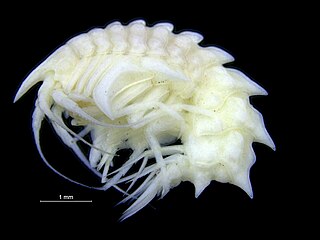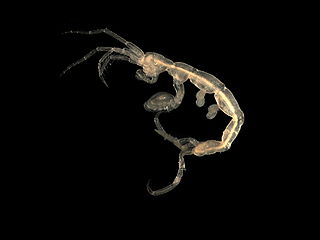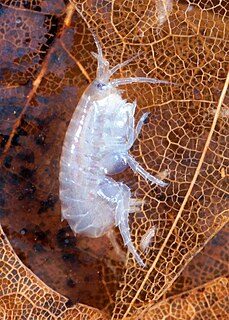
Amphipoda is an order of malacostracan crustaceans with no carapace and generally with laterally compressed bodies. Amphipods range in size from 1 to 340 millimetres and are mostly detritivores or scavengers. There are more than 9,900 amphipod species so far described. They are mostly marine animals, but are found in almost all aquatic environments. Some 1,900 species live in fresh water, and the order also includes terrestrial animals and sandhoppers such as Talitrus saltator.

Homarus gammarus, known as the European lobster or common lobster, is a species of clawed lobster from the eastern Atlantic Ocean, Mediterranean Sea and parts of the Black Sea. It is closely related to the American lobster, H. americanus. It may grow to a length of 60 cm (24 in) and a mass of 6 kilograms (13 lb), and bears a conspicuous pair of claws. In life the lobsters are blue, only becoming "lobster red" on cooking. Mating occurs in the summer, producing eggs which are carried by the females for up to a year before hatching into planktonic larvae. Homarus gammarus is a highly esteemed food, and is widely caught using lobster pots, mostly around the British Isles.

Epimeriidae is a family of relatively large amphipods found in cold oceans around the world.

Gammaridae is a family of amphipods. In North America they are included among the folk taxonomic category of "scuds", and otherwise gammarids is usually used as a common name.

Gammarus roeseli is a species of freshwater amphipod native to Europe.

Gammarus acherondytes, the Illinois cave amphipod, is a species of crustacean in the family Gammaridae. The crustacean is endemic to the Illinois Sinkhole Plain of Monroe County and St. Clair County, in southwestern Illinois, including Illinois Caverns State Natural Area.

Gammarus is an amphipod crustacean genus in the family Gammaridae. It contains more than 200 described species, making it one of the most species-rich genera of crustaceans. Different species have different optimal conditions, particularly in terms of salinity, and different tolerances; Gammarus pulex, for instance, is a purely freshwater species, while Gammarus locusta is estuarine, only living where the salinity is greater than 25‰.
Gammarus hyalelloides is a species of amphipod crustacean in the family Gammaridae. It is endemic to four springs in Jeff Davis County and Reeves County, Texas, and is listed as a vulnerable species on the IUCN Red List.

Pariambus typicus is a species of amphipod crustacean. It is found in the Atlantic Ocean from northern Norway south to the Cape Verde Islands and into the Mediterranean Sea as far east as Italy. It is absent from the Baltic Sea, suggesting that it requires water of high salinity. Adults grow to a length of 7 millimetres (0.28 in), and are commonly found in association with starfish and sea urchins, and more rarely with brittle stars. The species is sometimes included in the family Pariambidae, but more usually in the Caprellidae.

Dikerogammarus villosus, also known as the killer shrimp, is a species of amphipod crustacean native to the Ponto-Caspian region of eastern Europe, but which has become invasive across the western part of the continent. In the areas it has invaded, it lives in a wide range of habitats and will prey on many other animals. It is fast-growing, reaching sexual maturity in 4–8 weeks. As it has moved through Europe, it threatens other species and has already displaced both native amphipods and previous invaders.

Hyalella azteca is a widespread and abundant species of amphipod crustacean in North America. It reaches 3–8 mm (0.12–0.31 in) long, and is found in a range of fresh and brackish waters. It feeds on algae and diatoms and is a major food of waterfowl.

Gammarus lacustris is an aquatic amphipod.
Nephropsis atlantica, sometimes called the scarlet lobsterette or scarlet clawed lobster, is a species of lobster from the Atlantic Ocean.
Caprella linearis is a species of skeleton shrimp in the genus Caprella. It is native to the North Atlantic, North Pacific, and the Arctic Ocean. It closely resembles Caprella septentrionalis with which it shares the same geographical distribution.
Martensia martensi is a species of amphipod crustacean, and the only species in the genus Martensia. It occurs in waters around Svalbard at depths of 37–95 metres (121–312 ft).

Cephalodella is a genus of rotifers in the family Notommatidae.
Luckia is a genus of amphipod crustaceans in the family Pontogeneiidae, with the sole species Luckia striki. It is found in hydrothermal vents in the Atlantic Ocean.
Pseudamphithoides incurvaria is a species of amphipod crustacean in the family Ampithoidae. It is native to shallow water in the tropical western Atlantic Ocean where it creates a home for itself from fragments of the algae on which it feeds. This seaweed contains certain chemicals that are distasteful and protect it from predatory fish.

Eurythenes is a genus of marine amphipods in the family Eurytheneidae.
Gammarus hoonsooi is a species in the genus Gammarus in the family Gammaridae, in the order Gammaridea - which belongs to the taxon amphipoda.









